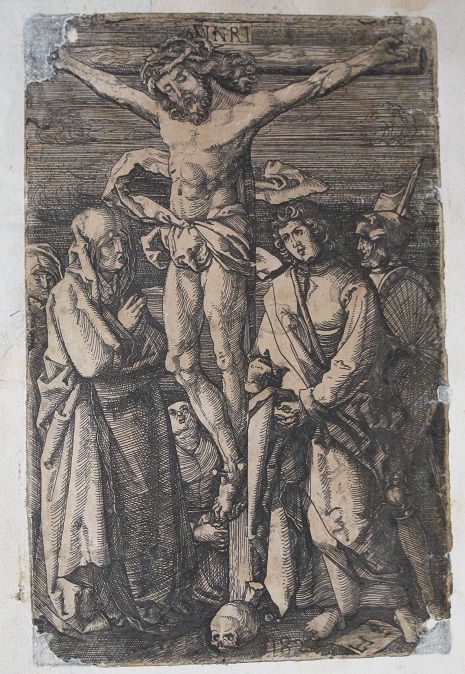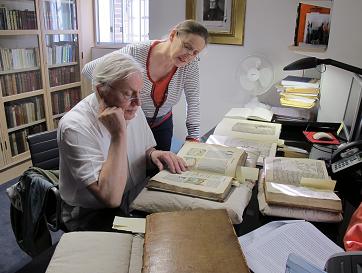Cambridge University Library is one of the world’s greatest repositories of books, and many of these books contain artworks. Some were printed with the text (book illustrations), some were added to the text after printing (painting and illumination), some were bound into a volume, and some were pasted on by later collectors. Regardless of the kind of image, pictorial elements in books can provide art historians and bibliographers with important information about the interrelated ways in which both kinds of printed material, books and art, were collected, used and valued over the centuries.
The copy of the Opuscula of Saint Bonaventure, Brescia: Bernardinus de Misintis, for Angelus Britannicus, 31 December 1497 (ISTC ib00930000; Inc.4.B.23.12[3713]) has a print of the Crucifixion with the Virgin and St John pasted onto the verso of the third upper free endpaper [Fig. 1]. The iconography, or standard visual formula, is a devotional image of the Crucifixion that traditionally faces the start of the Canon of the Roman Catholic Mass (Canon missae) in missals. The print is undated, and it is signed ‘LH’, the monogram of Lambrecht Hopfer (Augsburg, active ca. 1525–1550), in the lower right corner.

Lambrecht Hopfer’s Crucifixion in the 1497 Opuscula (Inc.4.B.23.12[3713])
 In December 2013, Ed Potten and Laura Nuvoloni travelled to Japan, at the invitation of Keio University, to participate in the international conference Text and illustration in early books and manuscripts: A comparative study. The conference, held on 13 and 14 December, was organised by Professor Takami Matsuda and Dr Satoko Tokunaga of the EIRI Project, with the collaboration of Dr Mayumi Ikeda, Postdoctoral Fellow of the Japan Society for the Promotion of Science. Keio University and Cambridge University have long had close ties. Cambridge’s copy of the Gutenberg Bible was the first to be digitized by the HUMI Project team in November 1998, led by Professor Toshiyuki Takamiya, himself a long-standing friend of Cambridge University Library and member of the Library’s Visiting Committee. Continue reading '’Text and illustration in early books and manuscripts: A comparative study” conference report from Ed Potten and Laura Nuvoloni'»
In December 2013, Ed Potten and Laura Nuvoloni travelled to Japan, at the invitation of Keio University, to participate in the international conference Text and illustration in early books and manuscripts: A comparative study. The conference, held on 13 and 14 December, was organised by Professor Takami Matsuda and Dr Satoko Tokunaga of the EIRI Project, with the collaboration of Dr Mayumi Ikeda, Postdoctoral Fellow of the Japan Society for the Promotion of Science. Keio University and Cambridge University have long had close ties. Cambridge’s copy of the Gutenberg Bible was the first to be digitized by the HUMI Project team in November 1998, led by Professor Toshiyuki Takamiya, himself a long-standing friend of Cambridge University Library and member of the Library’s Visiting Committee. Continue reading '’Text and illustration in early books and manuscripts: A comparative study” conference report from Ed Potten and Laura Nuvoloni'»

Tim Munby (1913-1974)
In June the Special Collections blog advertised an exhibition in the Library to coincide with a conference – held at King’s College – in honour of Tim Munby, Librarian of King’s from 1947 until his early death in 1974, who was born a century ago this year. The exhibition drew extensively on Tim’s own library of sale catalogues and bibliographical works, a large portion of which (1800 volumes) was purchased by the University Library after his death. But with the actual centenary of his birth approaching (he was born on Christmas Day 1913), we thought this a good time to consider the many donations he made to the Library during his lifetime. These include four incunabula (in addition to a further incunable owned by Munby which was bought by the Library), recently catalogued online as part of the Library’s five-year incunabula cataloguing project, and many rare eighteenth- and nineteenth-century books.
Continue reading 'Tim Munby’s donations to Cambridge University Library, a post by Laura Nuvoloni and Liam Sims'»
 Following on from Sir Quentin Blake’s visit on 4 October, the Incunabula Project Team was delighted yesterday to welcome Sir David Attenborough and his daughter Susan to the Library. Sir David will be one of the contributors to our forthcoming treasures book, writing up Cambridge University Library’s copy of the Hortus sanitatis, printed in Mainz by Jacob Meydenbach, 23 June 1491 (Inc.3.A.1.8[37]).
Following on from Sir Quentin Blake’s visit on 4 October, the Incunabula Project Team was delighted yesterday to welcome Sir David Attenborough and his daughter Susan to the Library. Sir David will be one of the contributors to our forthcoming treasures book, writing up Cambridge University Library’s copy of the Hortus sanitatis, printed in Mainz by Jacob Meydenbach, 23 June 1491 (Inc.3.A.1.8[37]).
The Hortus sanitatis, or the Garden of Health, is a vade mecum of all things natural, herbal, medicinal and mythical. Illustrated throughout with woocuts, hand-coloured in the University Library copy, it draws its source material from the classical authors, from ancient histories, medieval bestiaries and a long and rich tradition of fable and folklore. The result is a potent encyclopaedic mixture of the real and the imaginary. Continue reading 'Sir David Attenborough and the Hortus sanitatis'»



